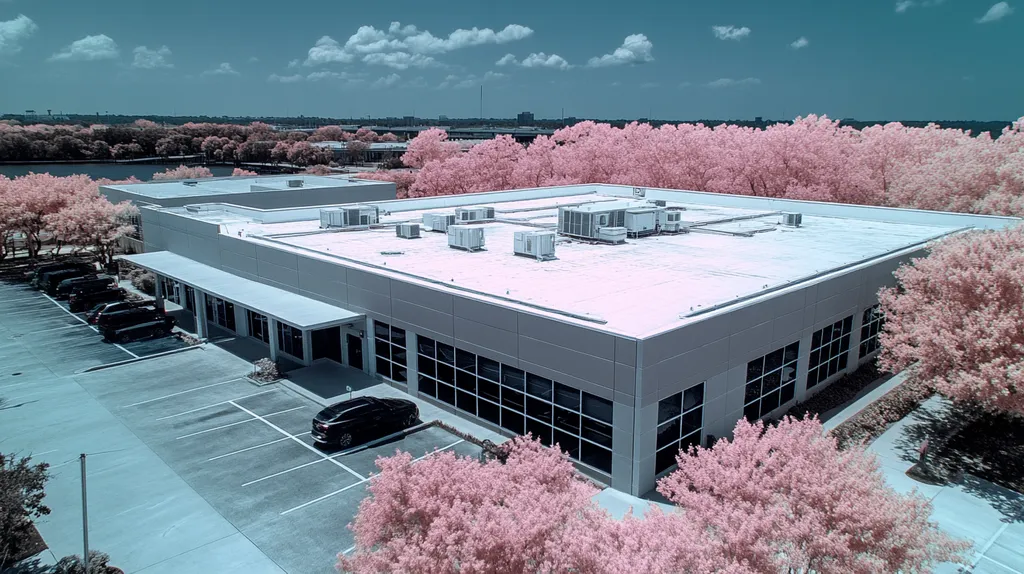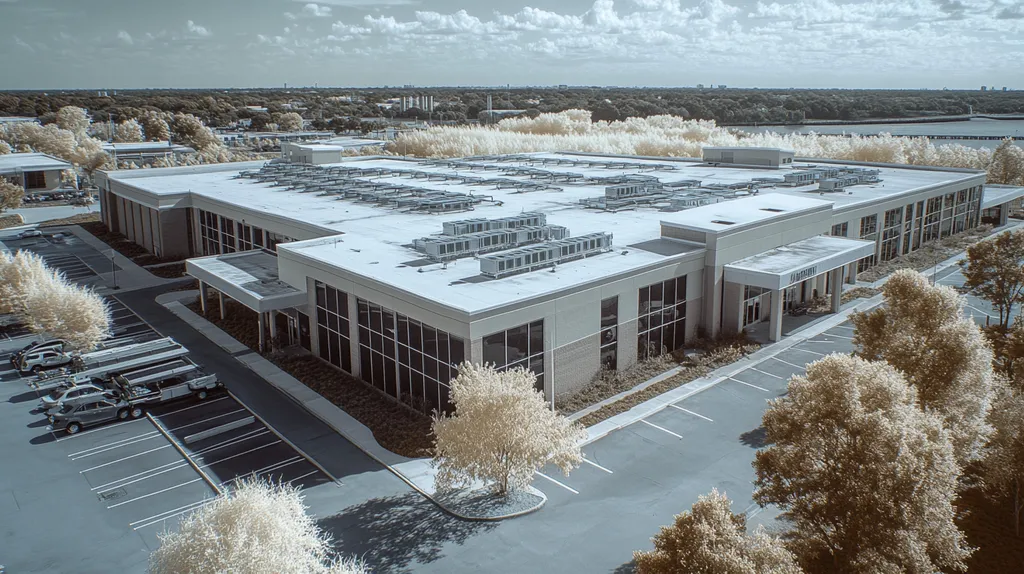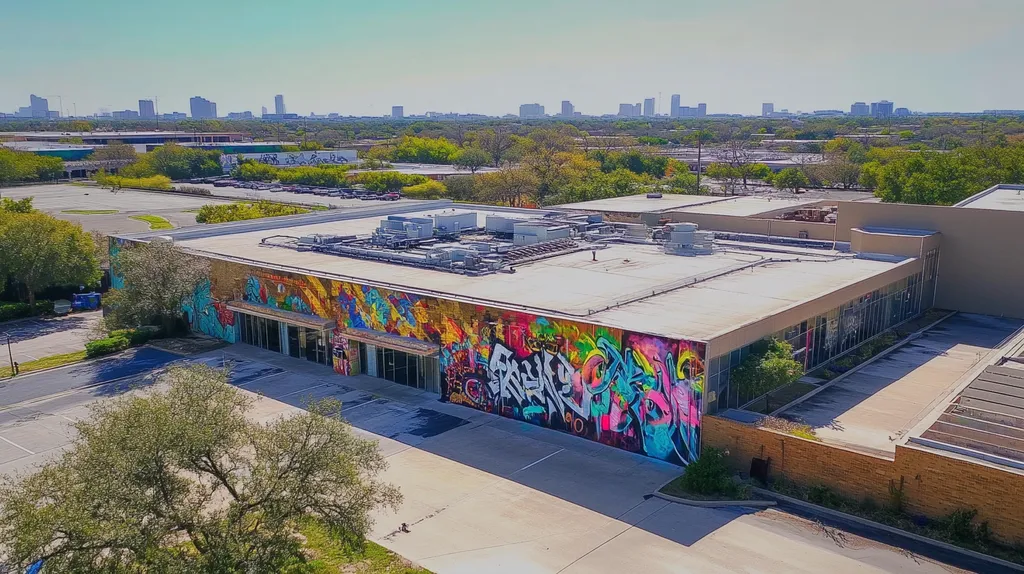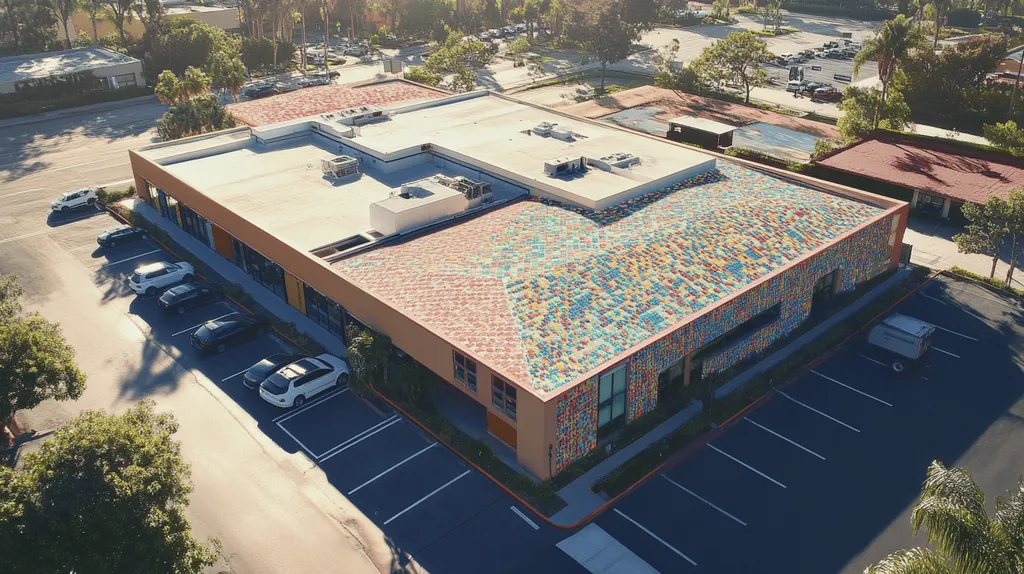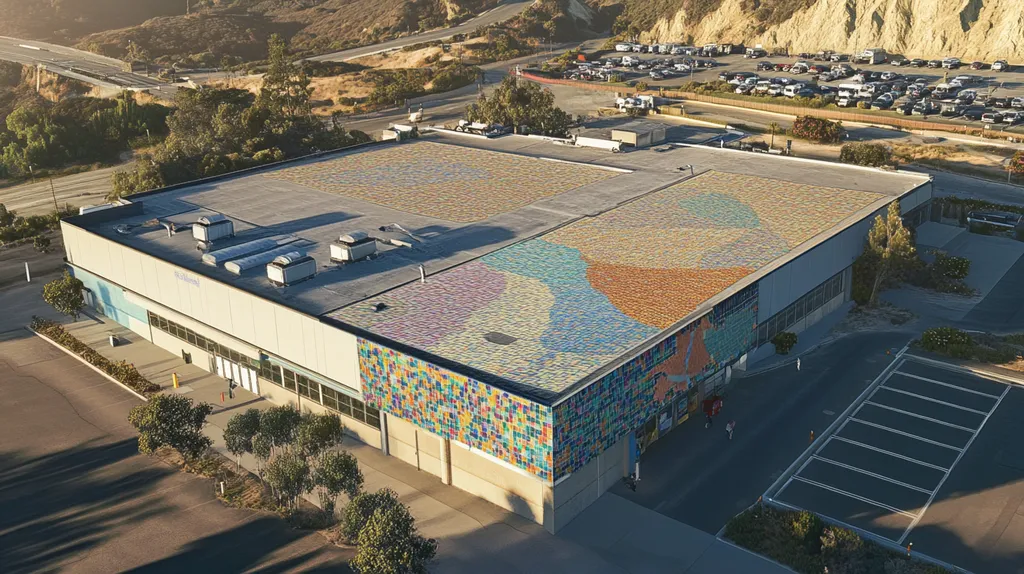In today’s competitive commercial real estate market, roof aesthetics can make the difference between attracting premium tenants and prolonged vacancies. Studies show that buildings with well-maintained, visually appealing roof coatings command up to 15% higher lease rates and experience 23% faster tenant placement.
Modern coating technologies have transformed commercial roofing from purely functional to architecturally significant, offering property owners unprecedented opportunities to enhance building value while ensuring protection. From reflective finishes that reduce energy costs to customized colors that reinforce brand identity, coating solutions deliver measurable returns on investment.
This comprehensive guide explores how roof coatings contribute to commercial property aesthetics, examining material options, application techniques, and maintenance strategies that maximize visual appeal.
SECTION 1: THE BASICS EXPLAINED
Commercial roof aesthetics have emerged as a critical factor in property valuation and tenant satisfaction. Studies show that buildings with well-maintained, visually appealing roofs command up to 15% higher lease rates in competitive markets. Beyond mere appearances, modern roof coatings blend functionality with design, creating opportunities for property owners to distinguish their buildings while ensuring long-term protection.
What It Is (In Plain Language)
Roof coatings represent specialized liquid applications that create a protective, aesthetically pleasing layer over commercial roofing systems. These coatings transform the appearance of commercial buildings while providing a clean and contemporary look that enhances overall property appeal. (source: Instacoat)
Modern coating systems come in various finishes, from matte to glossy, and countless color options to match corporate branding or architectural requirements. The coating layer acts like a durable shield, protecting the underlying roofing material while maintaining its attractive appearance.
Advanced formulations incorporate reflective properties that contribute to both visual appeal and energy efficiency. These coatings can transform an aging roof surface into a sleek, modern finish that elevates the entire building’s appearance.
Why It Matters (To Your Building)
The visual impact of roof coatings extends beyond surface-level aesthetics to influence property value and marketability. A well-executed coating system can become a key differentiator in competitive real estate markets.
For retail and commercial spaces, roof appearance directly affects customer perception and first impressions. Clean, attractive roofing surfaces signal professional management and attention to detail, qualities that resonate with potential tenants and visitors.
The aesthetic value of roof coatings plays a crucial role in urban environments where buildings compete for visibility. Properties featuring visually appealing roofs often achieve higher occupancy rates and command premium rental prices.
Strategic color choices in roof coatings can complement architectural features and enhance overall building design. This attention to detail helps create a cohesive visual identity that strengthens brand presence.
How It Works
Roof coating systems utilize advanced polymer technologies to create durable, weather-resistant surfaces that maintain their appearance over time. The application process begins with thorough surface preparation to ensure optimal adhesion and longevity.
Professional contractors apply coatings in carefully controlled layers to achieve uniform coverage and consistent visual appeal. This systematic approach ensures both protective performance and aesthetic excellence.
Modern coating formulations incorporate UV-stable pigments and reflective materials that resist fading and discoloration. These features help maintain the roof’s attractive appearance while contributing to building energy efficiency.
Regular maintenance of coated surfaces preserves both their protective capabilities and visual appeal. Simple cleaning and periodic inspections help extend the coating’s aesthetic benefits throughout its service life.
SECTION 2: PRACTICAL APPLICATIONS
In today’s competitive commercial real estate market, roof aesthetics can make or break a property’s success. Modern coating solutions offer property owners powerful tools to enhance visual appeal while maintaining structural integrity. With proper coating applications increasing property values by up to 20% and reducing vacancy rates, understanding practical implementation has become essential for facility managers and building owners.
Common Uses & Examples
The versatility of modern coating systems allows property owners to achieve multiple aesthetic goals simultaneously. Premium reflective coatings can be customized to match corporate branding while delivering superior protection and energy efficiency.
Decorative coating systems transform aging roof surfaces into attractive architectural features. Textured finishes can mimic expensive materials like slate or copper, providing upscale appearances without the associated weight or structural requirements.
Roof coatings offer more than just protection – they can transform the appearance of commercial buildings through fresh, contemporary finishes that enhance overall curb appeal. (source: Instacoat)
In urban environments, coating color selection helps buildings stand out while complementing surrounding architecture. This strategic approach to aesthetics supports brand identity and attracts premium tenants.
When You Need It Most
Timing coating applications to maximize aesthetic impact requires careful planning. The ideal window for application often coincides with early signs of visual deterioration, before serious degradation occurs.
Property owners should evaluate coating needs during routine maintenance cycles, typically every 3-5 years. This proactive approach prevents unsightly aging while protecting the underlying roofing system.
Major renovations or repositioning efforts present perfect opportunities to refresh roof aesthetics. A well-timed coating application can dramatically enhance overall project impact and return on investment.
Buildings facing increased market competition often benefit from immediate coating upgrades. Fresh, attractive roof surfaces help properties maintain competitive advantages in demanding markets.
Interactions With Other Systems
Successful coating applications must consider the entire roofing ecosystem. Proper integration with drainage systems, mechanical equipment, and existing waterproofing ensures both beauty and functionality.
Different base materials require specific coating formulations to achieve optimal aesthetic results. Single-ply membranes, metal roofing, and built-up systems each demand tailored approaches to color retention and finish quality.
Solar installations and rooftop amenities influence coating selection and application patterns. Strategic use of reflective and non-reflective zones can enhance both appearance and performance.
Building ventilation and HVAC systems must be considered when planning aesthetic improvements. Proper coating specification prevents discoloration around high-heat areas while maintaining visual consistency.
SECTION 3: KEY TERMINOLOGY DECODED
In today’s competitive commercial real estate market, understanding roofing terminology can mean the difference between making informed decisions and costly mistakes. Studies show that miscommunication due to terminology confusion leads to 23% of roofing project complications. As coating technologies advance and aesthetic requirements become more sophisticated, mastering these terms becomes crucial for property success.
Essential Terms Explained
Coatings are specialized liquid applications that create protective, aesthetically-enhancing layers over commercial roofing systems. A well-maintained commercial roof with appropriate coatings not only protects your investment but ensures energy efficiency and prolongs building lifespan. (source: Boomerang Building)
Reflectivity ratings indicate how effectively a coating reflects solar radiation. Higher ratings mean better heat reflection, with premium coatings reflecting up to 85% of solar energy, leading to significant cooling cost reductions.
Emissivity measures how efficiently a surface releases absorbed heat. Modern coating systems combine high reflectivity with optimal emissivity to maintain consistent roof temperatures and preserve aesthetic appeal.
Durability ratings indicate a coating’s resistance to weathering, UV exposure, and physical stress. Understanding these ratings helps predict appearance retention and maintenance requirements over time.
Industry Jargon Translated
The term “mil thickness” refers to the coating’s measured depth, with one mil equaling 1/1000th of an inch. Most aesthetic coatings require 20-30 mils for optimal appearance and protection.
“Surface preparation profile” describes the microscopic roughness needed for proper coating adhesion. Think of it as creating tiny anchors that help the coating grip the roof surface.
“Dry film thickness” (DFT) represents the final coating depth after curing. This measurement is crucial for achieving both the desired appearance and protective properties.
“Flash point” indicates the temperature at which coating materials become combustible. This safety-related term impacts application timing and methods, especially in warm climates.
Measurement & Units Simplified
Coverage rates are typically expressed in square feet per gallon. A standard 5-gallon bucket might cover 500 square feet, depending on surface texture and coating type.
Viscosity measurements indicate how easily coatings flow during application. Lower numbers mean thinner coatings that spread more easily but may require multiple layers for desired aesthetics.
Wind uplift resistance is measured in pounds per square foot (psf). Higher numbers indicate better resistance to wind damage, which helps maintain aesthetic integrity during storms.
Temperature requirements are given in degrees Fahrenheit, with most coatings needing 50-90°F for optimal application and appearance. Understanding these ranges ensures proper curing and long-term visual appeal.
SECTION 4: DECISION FACTORS
When selecting commercial roof coatings, property owners face decisions that impact both immediate aesthetics and long-term building performance. Studies indicate that poorly chosen coatings can reduce property values by up to 25% and increase energy costs by 40%. Strategic coating decisions must balance visual appeal, durability, and cost-effectiveness while considering regional climate factors and building-specific requirements.
Cost Considerations
Initial coating investments typically range from $2-8 per square foot, varying by material quality and application complexity. Premium coatings command higher upfront costs but often deliver superior longevity and performance benefits.
Architectural coatings combine aesthetics, customization, durability, energy efficiency, and waterproofing capabilities into one beautiful solution, revolutionizing how businesses design their commercial properties. (source: Hometown Station)
Labor costs represent 40-60% of total coating expenses. Professional installation ensures proper adhesion and uniform coverage, critical factors for both appearance and protection.
Energy savings from reflective coatings can offset initial investments within 3-5 years. Buildings in warm climates often see cooling cost reductions of 15-25% after coating application.
Performance Trade-offs
Coating thickness directly influences both aesthetics and protection. Thicker applications provide better waterproofing but may sacrifice smooth appearance, while thinner coats offer superior finish but reduced durability.
UV resistance varies significantly between coating types. Silicone-based products excel in sun exposure but carry premium costs, while acrylics offer good UV protection at moderate price points.
Weather resistance capabilities differ across coating categories. Some excel in extreme temperatures but show reduced flexibility, while others maintain elasticity but require more frequent maintenance.
Chemical resistance becomes crucial near industrial exhaust systems. Specialized formulations protect against specific contaminants while maintaining aesthetic appeal.
Lifespan & Durability Factors
Expected coating lifespans range from 10-25 years depending on material quality and environmental conditions. Premium products typically offer superior color retention and surface integrity throughout their service life.
Climate exposure significantly impacts coating durability. Coastal properties require enhanced salt resistance, while urban locations need superior pollution resistance.
Maintenance requirements vary by coating type. Some systems need annual inspections and periodic recoating, while others maintain appearance with minimal intervention.
Warranty coverage differs substantially between manufacturers. Premium coatings often include longer guarantees and broader protection against appearance degradation.
SECTION 5: COMMON CHALLENGES
Commercial roof coating challenges can significantly impact both aesthetics and property value. Industry data shows that inadequate coating maintenance leads to a 30% reduction in roof lifespan and up to 40% increase in energy costs. Understanding and addressing these challenges proactively helps property owners maintain visual appeal while protecting their investment from premature deterioration.
Frequent Problems & Solutions
Surface preparation issues represent the leading cause of coating failures. Proper cleaning, primer application, and moisture testing before installation prevent blistering and peeling that can mar appearance.
Inconsistent application thickness often results in uneven appearance and premature wear. Professional contractors use specialized equipment to ensure uniform coverage that maintains visual appeal while providing consistent protection.
Roof coatings offer more than just protection – they can transform the appearance of commercial buildings through fresh, contemporary finishes that enhance overall curb appeal. (source: Instacoat)
Poor drainage patterns create ponding water that degrades coating appearance. Installing additional drains or tapered insulation helps maintain surface integrity and aesthetic value.
Warning Signs To Watch For
Discoloration and chalking indicate UV degradation of the coating surface. Regular inspections help identify these early warning signs before they impact building appearance.
Blistering and separation from the substrate signal moisture infiltration. Addressing these issues promptly prevents expanding damage that compromises both aesthetics and protection.
Cracking and alligatoring reveal coating stress and aging. These surface patterns typically appear first in high-traffic areas and around roof penetrations.
Loss of reflectivity manifests as dulling and darkening of previously bright surfaces. This change affects both appearance and energy efficiency.
Preventative Approaches
Scheduled maintenance inspections catch problems early when repairs are simpler and less costly. Quarterly visual assessments help maintain consistent appearance and coating performance.
Professional cleaning removes debris and contaminants that accelerate coating degradation. Regular washing prevents staining and maintains reflective properties.
Touch-up applications address minor damage before it spreads. Having matching coating materials on hand enables quick aesthetic repairs.
Documentation of coating conditions through photos and inspection reports tracks deterioration patterns. This data helps optimize maintenance timing and preserve visual appeal.
SECTION 6: NEXT STEPS & RESOURCES
The aesthetic impact of commercial roof coatings directly influences property value, tenant satisfaction, and market positioning. Studies show that buildings with visually appealing roofs command 15-20% higher occupancy rates and stronger tenant retention. As competition in commercial real estate intensifies, property owners must take decisive action to maintain their competitive edge through strategic roof coating decisions that enhance both appearance and functionality.
Questions To Ask Providers
Begin by asking potential contractors about their experience with similar buildings and coating systems. Request detailed portfolios showing before-and-after transformations of comparable properties.
Discuss specific coating formulations and their aesthetic performance records. Quality providers should explain how different products maintain their appearance over time and what factors influence color stability.
Inquire about surface preparation methods and application techniques. Professional contractors will detail their process for ensuring uniform coverage and consistent visual appeal.
Request information about warranty coverage for appearance-related issues. Understanding what aspects of aesthetic performance are guaranteed helps protect your investment.
Industry Standards & Guidelines
Familiarize yourself with ASTM D6083 standards for roof coating performance. This benchmark ensures selected products meet minimum requirements for durability and appearance retention.
Review Cool Roof Rating Council (CRRC) ratings for reflective properties. Higher ratings indicate better long-term appearance and energy efficiency performance.
Understand FM Global and UL requirements for fire resistance and weather protection. These standards influence coating selection while maintaining aesthetic goals.
Consider Leadership in Energy and Environmental Design (LEED) criteria when selecting coatings. Many attractive options contribute to sustainability certification points.
Further Learning Simplified
Join professional organizations like the National Roofing Contractors Association (NRCA) for access to educational resources. Their technical bulletins provide valuable insights into coating performance and aesthetics.
Attend industry trade shows and seminars focused on commercial roofing. These events showcase new coating technologies and application techniques that enhance visual appeal.
Subscribe to leading industry publications that regularly feature coating case studies. These real-world examples demonstrate successful aesthetic transformations and maintenance strategies.
Participate in manufacturer training programs that detail proper application methods. Understanding these techniques helps ensure optimal aesthetic results for your property.
The Bottom Line
With commercial property values increasingly tied to aesthetic appeal, roof coatings have emerged as a critical factor in market success, commanding up to 15% higher lease rates and 23% faster tenant placement.
Modern coating technologies offer unprecedented opportunities to enhance building appearance while ensuring protection, with premium solutions delivering ROI through reduced energy costs, extended roof life, and improved tenant satisfaction.
The future of commercial roofing lies in these innovative coating solutions that blend visual appeal with performance.
Property owners who prioritize coating aesthetics position themselves for sustained market leadership, while those who delay risk falling behind in an increasingly competitive real estate landscape.
Smart investment in quality roof coatings today ensures both immediate visual impact and long-term property value protection.
FREQUENTLY ASKED QUESTIONS
Q. What are commercial roof coatings in simple terms?
A. Roof coatings are specialized liquid applications that provide protection and visual appeal to commercial roofing systems. They create a fresh, stylish look, enhancing your building’s appearance while safeguarding it from weather damage. These coatings come in various colors and finishes to suit your aesthetic preferences and needs.
Q. How do commercial roof coatings affect property value?
A. Applying roof coatings can significantly increase property values by up to 20%. They enhance visual appeal, which attracts more tenants and customers. Properties with well-maintained and aesthetically pleasing roofs often experience higher occupancy rates and can command premium rental prices in competitive markets.
Q. What are the best practices for applying coatings to an industrial roof?
A. For industrial roofs, ensure proper surface preparation before coating application, including cleaning and moisture testing. Hiring experienced professionals for uniform application is crucial to achieve desired aesthetics and long-lasting performance. Regular inspections and maintenance also play a key role in preserving both the coating’s appearance and functionality over time.
Q. How do I choose the right commercial roof coating materials?
A. Selecting the right coating material involves considering factors like climate, building type, and desired aesthetics. Research different formulations and their longevity, reflectivity, and resistance to wear. Consult with professionals who can recommend suitable products based on your specific requirements and ensure the selected option enhances both appearance and performance.
Q. What common challenges do commercial roof coatings face?
A. Issues like surface preparation, uneven application, and poor drainage can hinder coating performance and aesthetics. Additionally, harsh weather conditions can lead to premature wear. Regular inspections, professional installation, and proactive maintenance are essential to address these challenges effectively and preserve both the roof’s appearance and functionality.
Q. Why should I consider the warranty when selecting coatings for my commercial roof?
A. Warranties indicate the coating manufacturer’s confidence in their product’s durability and performance. They often cover appearance-related issues and help protect your investment. Understanding warranty terms ensures that you choose coatings that meet your long-term aesthetic and functional needs while minimizing future costs.
Q. How can I maintain the aesthetics of my commercial roof coatings?
A. Regular maintenance is key to preserving your roof’s appearance. Schedule inspections to identify early signs of wear, and perform cleaning to remove debris. Promptly address any minor damage with touch-up applications. This proactive approach keeps your coating looking fresh and helps extend its lifespan.

